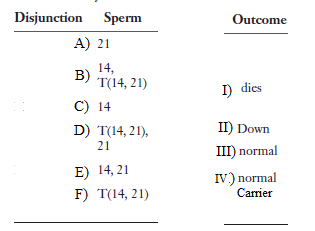#Question id: 5672
#Unit 5. Developmental Biology
Following statements are regarding to recognition of sperm by mammalian zona pellucida.
A. Sperm that have undergone the acrosome reaction bind directly to zona protein ZP2 and begin making a channel toward the oocyte.
B. Sperm with an intact acrosome bind to ZP2; they undergo the acrosome reaction on the zona pellucida and then transfer their binding to ZP3.
C. When a sperm reaches the oocyte and fuses with it, the cortical granules release proteins that digest portions of ZP2 and ZP3, making them nonfunctional and prevent polyspermy.
D. When a sperm reaches the oocyte and fuses with it, the cortical granules release proteins that digest ZP3 only, not ZP2 because ZP2 involve in the process of slow block to polyspermy.
Which of the above statements are correct?
#Question id: 5673
#Unit 5. Developmental Biology
Species-specific sperm attraction has been documented in numerous species. In echinoderms, sperm are attracted toward eggs of their species by chemotaxis. Following statements are about chemoattraction-
A. In this process Sperm follows a gradient of a chemical secreted by the egg.
B. These oocytes control only the type of sperm they attract, but not the time at which they attract them.
C. Releasing the chemotactic factor only when the sea urchin egg has completed all of its meiotic divisions .
D. Releasing the chemotactic factor only when the sea urchin egg is in second metaphase of its meiotic division.
E. The mechanisms of chemotaxis differ among species and chemotactic molecules are different even in closely related species.
Which of the following statement are incorrect about this process?
#Question id: 5674
#Unit 5. Developmental Biology
Following statements are regarding to the mechanism of migration of pollen tube.
A. The embryo sac is the product of three mitotic divisions of the diploid megaspore; it comprises seven cells and eight haploid nuclei.
B. The two polar nuclei in the central cell will fuse with the second sperm nucleus and produce the endosperm that will nourish the egg. The other six cells, including the egg, contain one haploid nucleus each.
C. After compatible pollen germinates, the pollen tube grows toward the micropyle.
D. The three cells from the pollen are connected to one another at the tip of the tube, and waves of sodium ions play a key role in the growth of the tube.
Which of the following combinations are correct?
#Question id: 5675
#Unit 5. Developmental Biology
Following are the statements related to mammalian chaemotaxis:
A. During chaemotaxis, the oocyte and its accompanying cumulus cells secrete molecules that attract only uncapacitated sperm toward the egg during the last stages of sperm migration.
B. These chaemotactic compound are hormone progesterone, which is made by the cumulus cells.
C. Progesterone has been shown to bind to a receptor that activates Ca2+ channels in the cell membrane of the sperm tail, leading to sperm hyperactivity and provides directional cue.
D. Cumulus cells also secrete a substance, CRISP1, that attracts sperm and hyperactivates them through CatSper channels similar as in sea urchins.
Which of the following statement is incorrect?
#Question id: 5676
#Unit 5. Developmental Biology
The importance of dynein can be seen in individuals with a genetic syndrome known as the Kartagener triad. which of the following statement is correct?
#Question id: 5677
#Unit 5. Developmental Biology
During acrosome reaction, after binding with the egg many sperm membrane proteins are activated. Which of the following membrane protein is not activated?

